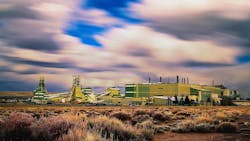Solvay trying Regenerative Thermal Oxidation to decarbonize Wyoming Mining ops
Belgian chemical company Solvay has engaged emissions control systems manufacturer Conifer Systems to support its sustainability efforts.
Under the terms of the agreement, Conifer Systems will design, manufacture and install a solution to cut the greenhouse gas (GHG) emissions from Solvay’s trona mine and soda ash production facility in Green River, Wyoming.
Trona is a mineral used in the production of soda ash for making glass, detergents, solar panels and lithium carbonate for electric vehicles.
The system, which is planned to be commissioned in the second quarter of 2024, will utilize regenerative thermal oxidation technology to help reduce GHG emissions at the facility by up to 20 percent, Conifer says.
The company claims its solution will be the largest mining abatement system in the Western Hemisphere and will consist of 10 regenerative thermal oxidizers.
The system will also feature advanced systems for energy and water management, as well as the potential for heat energy recovery. It will be operated using Conifer’s proprietary process control technology and could be scaled to increase GHG destruction capacity by 20 percent in the future.
Trona is a mineral used in the production of soda ash for making glass, detergents, solar panels and lithium carbonate for electric vehicles.
“This project reflects Solvay’s commitment to voluntarily decarbonize its operations for a carbon-neutral future and its willingness to invest in innovation,” Solvay’s project director Matteo Paperini said.
Solvay has pledged to make its operations carbon-free in alignment with its 2030 sustainability program, Solvay One Planet.
Headquartered in Houston, Texas, Conifer Systems designs, manufactures and installs emissions control systems and provides aftermarket services to enable industries to meet and exceed their environmental goals.
